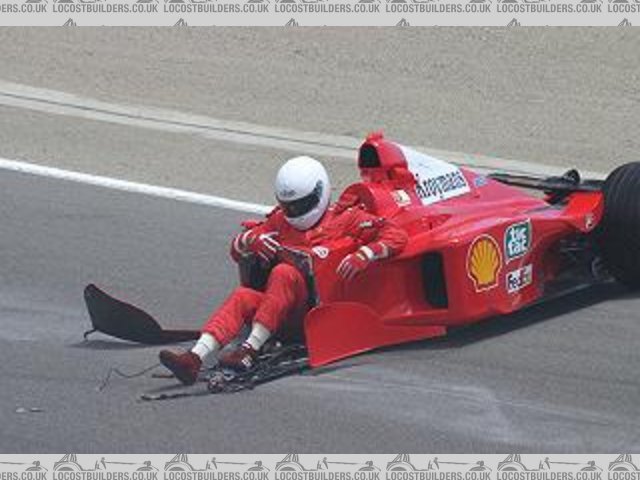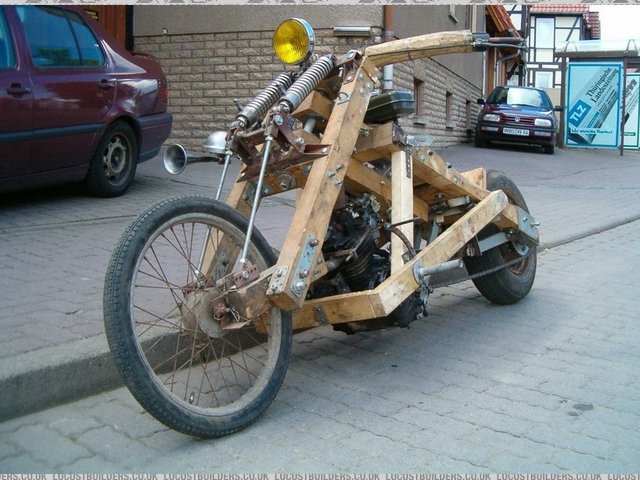Who reckons they could make a locost chassis from it? (that would be strong enough for the road, obviously)


I was looking here: Link to Polyfibre price list and saw that they sell carbon
fibre tubes for reasonable money. The largest tube is 1" OD and 16 SWG thick. It is available in 5 metre lengths and sold at £10.75 + VAT per
metre.
Who reckons they could make a locost chassis from it? (that would be strong enough for the road, obviously)
The question is, how do you bond the tubes together to give any strength?
And IMHO, a CF space frame would not work so well.....CF doesnt work well in compression...
I would feel safer with a properly engineered lightweight steel chassis!

quote:
Originally posted by tegwin
And IMHO, a CF space frame would not work so well.....CF doesnt work well in compression...
quote:
Originally posted by 02GF74
bike frames ... bamboo
yes and CF bikes still readily fracture, (yes they do ive seen it happen more than once) and they are not carry a 200KG engine and gear box at 150 mph. I too would rather have a steel chassis than a bonded CF structure. The bond line is always the failure point!
quote:
Originally posted by smart51
quote:
Originally posted by 02GF74
bike frames ... bamboo
That I would like to see.
If you could design a joint then I guess you'd end up with something that is lighter and stiffer. But if you had a prang (and lets face it - this
is a race car) how would you be able to tell whether the chassis had been damaged beyond use? Steel can deform and bounce back with no weakening.
Deform and not bounce back is different but is also visible. CF may deform and shatter (easy to spot of course) or deform and recover but, unlike
steel CF can be significantly weakened. That IMHO is the brittle nature of CF is its Achilles heal. The aerospace industry mitigates against this by
performing regular NDT inspections - but that is not an option for the average amateur. I wonder if the need for NDT is what makes the Maclaren
F1's annual service £30k?
You could sensibly use CF in non-Jesus bolt applications - where its failure would not be catastrophic for the vehicle. Bodywork, seats, etc - where
the weight saving justifies it.
How about using CF for the drive shaft? Light weight and in that use you can control the loads that the tube sees far more easily. If it fails the car
just stops and at least it is encased. Donkervoort have done one.
quote:
Originally posted by StuartBJ
yes and CF bikes still readily fracture, (yes they do ive seen it happen more than once) and they are not carry a 200KG engine and gear box at 150 mph. I too would rather have a steel chassis than a bonded CF structure. The bond line is always the failure point!

quote:
Originally posted by TimC
quote:
Originally posted by smart51
quote:
Originally posted by 02GF74
bike frames ... bamboo
That I would like to see.
Have you ever seen scaffolding in Hong Kong? Wow!
carbon my big bottom  rather use tinfoil!
rather use tinfoil!


Rescued attachment FerrariF1Crash.jpg
I've broke a few fishing rods in my time...
That's just casting 6oz of lead off Dover harbour wall. 
Paul G
quote:
Originally posted by smart51
quote:
Originally posted by 02GF74
bike frames ... bamboo
That I would like to see.
The broken ferrari shown in the one of the previous responses was later discoverd to have ben made incorrectly. All the ply joints were in the one
place rather than distributed around the tub so not a good illustration.
The problem with using carbon in frame like structures if you are using premade tubes is the need to joining pieces at each interface obviously these
can become very complicated. The advantage of using a moulded carbon chassis is that you don't necessarily need to then add the bodywork that
would be required on a spaceframe.
Fundamentaly you need deep pockets and know what you are doing to make it worthwhile.
Humm bambo 7 
Bamboo is stronger (for some values of stronger) than carbon or steel.
I've watched documentary’s that show the bamboo scaffolding, quite impressive
Thing to remember about carbon is its strength is all in tension, in compression it is quite bad and tends to crumble. You can see this in crash test
of F1 nose cones where the energy is dissipated by the disintegrating shell literally turning to dust. In a crash a tubed chassis is libel to snap
from the shock and produce dangerous sharp poles which could impale you. It's a good material but that doesn't mean it can be used in
everything.
I'm sure another aluminum space frame thread would have generated more heat than this. Is there a bit of Mondayness going on?
quote:
Originally posted by smart51
I'm sure another aluminum space frame thread would have generated more heat than this. Is there a bit of Mondayness going on?


And won't someone just stop and think about the kittens!!! 
I'm sure newspaper first coated in wall paper paste and wrapped up really tight would offer a locost alternative to expensive steel. The plastic joints used in tents could be used to join them, Airfix glue should be used here. Plus paper mache body panels would make a good environmental alternative to nasty glassfiber.
I`m not trying to dishearten you by any means, its just the fact of the matter that CF for novice applications is best left to non structural
appications.
Yes steel and aluminium frames fracture also, usually at the weld point, where you have to exceed the weld strength (another topic for another day)
and not the bond strength or peel ply layer in CF.
Also if you do damage it you will more than likely get some form of ductile/plastic deformation (see the recent bending wishbone thread) in steel and
ali, as opposed to a brittle faiure from a CF component.
My point is, I would not like to be applying whopping bending moments, and tensile/compressive forces to a very unforgiving material. CF is not the
be all and end off of materials, yes its stiffer, and slightly lighter (modulus of stiffness) than ali but even advanced aerospace companies don`t
know how to accuratly model and design to fully utilise the material. If you are in the position where you have the FEA suites, and advanced pre-preg
and processing equipment to fully consolidate your composite then you will probably be ok, but not always. I recently examined some korean prepreg
sample, with quick release fastners installed and even though the panel looked ok, the installation of the fasteners had caused the material to be
next to useless due to micro cracking. The cracks for aerospace regs state that the cracks can not exceed 0.35mm in length and inmitiate no further
than the 2nd ply layer, due to the fact that above those values the life expectency of the sample it greatly reduced to unsafe levels (for aerospace).
Drilling into CF weakens it due to nano/microcrack formation, hence bonding it tends to be used.
The cracks occurred from a simple drilling and installation proceedure and that was using some of the most uptodate techniques and best materials
avaliable.
I can forsee it being a bit painful if your lovely CF bike frame splinters in two, but just imagine that happening in a car if your crack has
propergated and a critical failure occurs. The likelyhood of this happening is far greater with poor materials and inexeprience.
PLUS all the cost!!!!! ££££$$$$££££
I`ll stick to steel thanks.
Sorry for the rant
Stuart...dont apologise, it all made good sense and needed to be said...it just is not a good amateur material.
My bikes carbon. Has a nice big crack at the bottom bracket which is setting me back £1500. STRONG but BRITTLE.
and my wheels
seatpost
stem
handlebars
water cages
pedals
soles of my shoes
I'm confused now..... I was under the impression that pointing out the potential practical problems (not to mention cost) associated with
fashioning something out of unobtainium and suspending it from sky hooks in your lean to shed was very un PC on here nowadays and that someone would
almost instantaneously pop up to brand any non believers as negative luddites who should shuffle off to finish reading this months edition of The
Automobile........ must have dreamt that happening then judging by this thread 
quote:
Originally posted by iank
Bamboo is stronger (for some values of stronger) than carbon or steel.
The last thing I would do it TELL someone not to do it; as we all learn by doing and making mistakes ..................and end up making 3 chassis
until we get it right (me included)
Don`t get me wrong, when processed correctly CF and other composites have advantages over other materials such as aluminium and steel.....thats why
they are used, but going down this route as a novice WILL cause nothing but empty pockets. I really do like the plain CF look and a bodyskin would
look fantastic, but if its nothing more than bodywork, what the point? It`s not providing rigidity, yes it would if it was a monocoque (Mc f1,
veyron)....(from an engineering point of view, not an artistic).
I`ve had similar arguments with many of the "max power" generation (i`m not calling anyone a chav or max powery type guy, im just recounting
past experience) and this applies to some guys that should know better and in the end it all boils down to aesthetics or a "look what i`ve got
factor" (95% of the time). The other 5% are guys who have a good idea and want to utilise a composite for its properties, but not always knowing
how to take advantage of them.
Anything is possible, there are things which i don`t know and can`t do, that why i`m on here so I can ask other that do know!
a bamboo locost...... now that would be fun
would it float????
quote:
Originally posted by Mark Allanson
quote:
Originally posted by iank
Bamboo is stronger (for some values of stronger) than carbon or steel.
What gas do you use to weld that then?


quote:
Originally posted by StuartBJ
a bamboo locost...... now that would be fun
would it float????

just use good old wood


Rescued attachment normal_HPIM0679k.jpg
^^^^ I love an original thinker 


Seriously though - Properly designed laminated wood is one of the lightest and best (and relatively cheap and easy to build) engineering materials
around.
[Edited on 28/4/08 by Ivan]
How about a LEGO locost???......how much fun would that be to make 